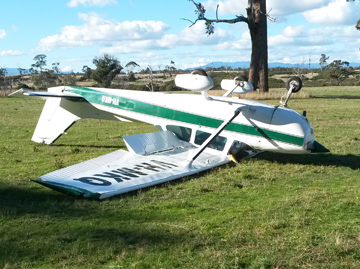
On 30 April 2014, the pilot of a Cessna 172 aircraft, registered VH-MKQ, was conducting a private flight from Launceston to a landing site about 13 km south-west of Launceston, Tasmania. Prior to departing Launceston, the pilot completed two circuits with stop-and-go landings, and confirmed the brakes were operating normally.
After a flight of about 6 minutes, the aircraft arrived overhead the landing site and the pilot overflew four times to assess the field. The pilot then conducted the approach as planned, however, when on final, he determined that the aircraft was too high and too fast to land so he conducted a go-around.
This incident highlights the importance of considering all of the factors when assessing a landing area.
On the second approach, the pilot established the aircraft on final, with full flap selected, and slightly lower and slower than the previous approach. The wheels touched down at the pilot’s selected point, and the aircraft bounced slightly. The pilot applied the brakes, and the aircraft began to decelerate, however, as he increased the pressure on the brakes, the brakes locked up and the aircraft continued towards a fence.
The pilot selected the fuel mixture to idle cut-off and the engine stopped. The aircraft collided with the fence and the nose landing gear entered a ditch. The aircraft nosed over and came to rest inverted. The aircraft was substantially damaged, and the pilot was uninjured.
This incident highlights the importance of considering all of the factors when assessing a landing area. The stopping distance required by an aircraft may vary considerably depending on the surface conditions.
Read the report: Runway excursion involving a Cessna 172, VH-MKQ, 13 km south-west of Launceston, Tasmania, on 30 April 2014


